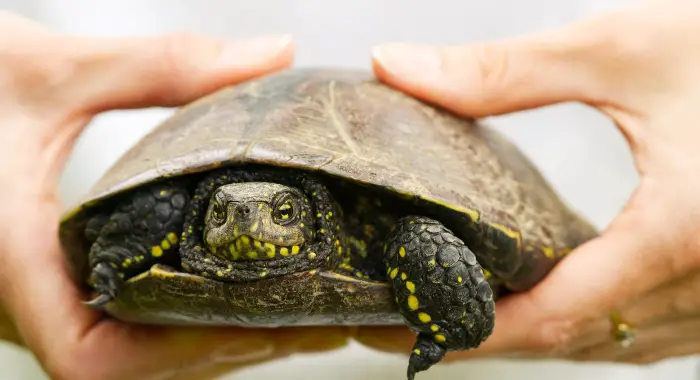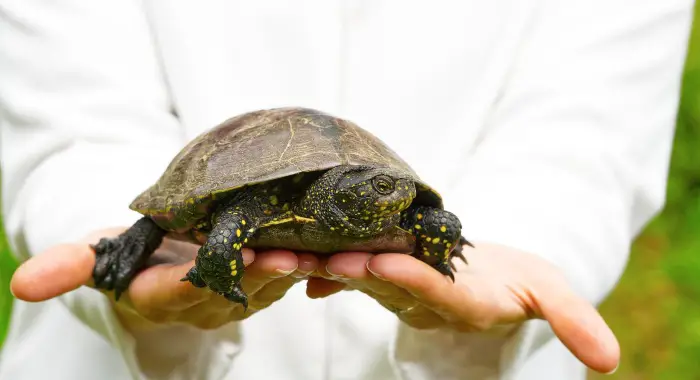Terrapins generally don’t like being handled. They are the oldest among all living reptiles, as they’ve been evolving for the past 215 million years.
Their primitive natural instincts tell them they should beware of anything bigger than them—which includes you. Since we look like giants to terrapins, they often assume we are predators, hence their shy and reserved demeanour.
Even so, as part of caring for a terrapin, you must learn how to hold it in order to check on its health and overall well-being. So, here are the basics you should know.
Terrapin behaviour
Terrapins are very delicate and timid creatures and may get frightened and alarmed when you try to pick them up.
You must give your terrapin plenty of time to trust you. Only then will it stop resisting or showing any aggression against you. Indeed, once it gets used to your handling, it may even swim across to reach you!
Earning the trust of your pet terrapin is essential, as it helps you check it up regularly for any signs of a visible infection or other discomfort.
The best way to do this is to start with hand feeding is the best way. This teaches your terrapin to associate you with food, thus becoming fearless about your handling. Try to give it tasty treats like seafood and other delicacies that terrapins particularly like. Your terrapin will slowly connect the idea of tasty food with you.
Gradually, you can start picking it up with utmost care. Check it up quickly and then place it gently back again in the tank. This practice followed by a treat of its favourite food like fish will make you more reliable—and likeable—to your terrapin.
How to handle a terrapin
While handling, the terrapin should be held firmly from the side of the shell. Never drop it on the floor from high up as that can break its shell, head, neck, or legs. Any such injury can be fatal for your pet.
Use both hands
Terrapins, particularly hatchlings and babies, seem quite small and manageable. Even so, you should handle your terrapin with both hands. It’s far safer and it keeps your terrapin from wiggling and falling off your hands.
The best way to handle your terrapin is to hold it with one hand on each side, between the front and back legs.
Adult terrapins are quite heavy and strong, so they require extra attention when handling and lifting. Since they have more strength, should be careful not to hold them too loosely. They can easily wriggle their front and back legs until they have freed themselves from your hands. They may even scratch you in their attempt to release themselves from your hold.
Terrapins don’t like being turned on their shell
Terrapins feel uneasy when they are lying on their shell. It makes them feel vulnerable and uncomfortable. You should never put your terrapin in this position unless you want to check its shell real quick. If you must hold your terrapin on its shell, inspect the shell fast and return the terrapin to its upright position.
Don’t squeeze your terrapin’s shell
No matter how hard your terrapin’s shell is, it’s still vulnerable. If you push, press, or squeeze it too much, you could break it.
This is particularly relevant if your terrapin is still young and the shell is soft. This is why you should hold your terrapin with both hands, as the pressure is spread on both hands and at two separate points on the shell.
Be delicate when you put your terrapin back on the ground
You should never your terrapin onto the ground from a height or with force, as you could break its fragile legs. Always be delicate and gentle when you put your terrapin back in its terrapinarium or on the ground. Don’t rush to drop it back to its habitat because you could cause internal injuries.
Don’t shake your terrapin
Needless to say, you should never shake your terrapin. Terrapins are fragile and their shells, no matter how hard they seem, are sensitive and made of living tissue. It might seem odd to humans that such a hard body part has any tactile sensitivity, but it does.
Also, don’t knock the terrapin’s shell against other surfaces: it can break and it’s highly unpleasant to the terrapin.
Don’t flip your terrapin
Don’t flip your terrapin 360 degrees because they get dizzy. Likewise, don’t flip your terrapin from front to back or upside down. Not only do they get woozy, but they can also suffer internal organ damage. If you need to check their underbelly, flip them 180 degrees first, wait a few seconds, and flip them again.
Be gentle
How would you behave with a puppy in your hands? Wouldn’t you be gentle with your movements?
It is easy enough to assume that terrapins can withstand anything because of their hard shell, but this isn’t true. Be gentle and careful when you hold your terrapin. Sudden and quick movements can make your terrapin feel unsafe, causing it to curl up inside its shell. It will also associate your handling with feeling uneasy and will likely be reluctant to let you hold it again in the future.
The goal is to build a trusting relationship with your terrapin. A stressed or upset terrapin may struggle and try to bite or scratch you while being handled. It is best to leave it alone when it’s like this.
Though most of the terrapins get used to the owner with time, some remain aggressive forever—and that should be respected.
Pre- and post-handling routine
Both pre- and post-handling, rinse your hands properly with soap and mild disinfectants to stay away from any contamination.
Like all reptiles, terrapins may suffer from illness and carry microorganisms like Salmonella, which can cause severe diseases in humans—particularly immuno-suppressed people.
Life with a terrapin
Proper handling is just one of several important factors that affect a terrapin’s well-being. They are cold-blooded reptiles that can’t generate body heat. That’s why they need a terrapinarium that is heated to help them maintain their body temperature.
- Tartarium 60 Turtle Terrapin Reptile Glass Tank with Ramp
- The tartarium 60, terrarium glass, is equipped with supports and dry zone in high quality white plastic with high gloss finish and a clear plastic lid for the rest of your turtle and for optimal exposure to heat, essential to their well-being and growth. Plastic supports; Plastic RAMP; Lid with clear plastic to prevent the turtle jump. Lid above ramp only, full lid not included or supplied.
- Aquarium Dimensions L60 x W29.6x H19.5 cm RAMP Dimensions L22.5 x W13 x H15.7 cm Black on ramp & decor is for illustration purposes only.
This needs a careful set-up of its surroundings with the provision of optimum temperature, natural or artificial light, nutritional food for terrapins, clean water, and medical attention in time. The size of the terrapinarium is also a matter of concern.
- Balanced uva to uvb ratio
- Typically x3 more usable uvb than most lamps
- Excellent colour emissions
Besides these, careful handling can give your terrapin a long life. To learn more about handling terrapins safely please read my Turtle Guide Book review.
Subscribe and DOWNLOAD The Complete Turtle & Terrapin Guide Book:





